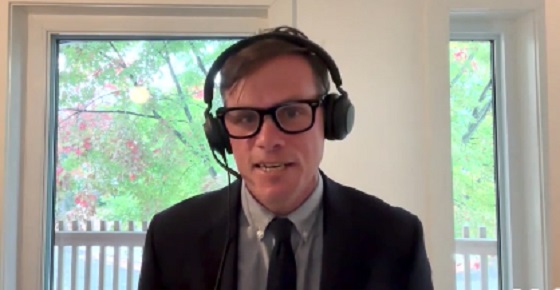International
Pentagon Salivates Over ‘Expensive’ Weapons While China Races Into Future With Iron Grip Over Cheap Drone Tech


From the Daily Caller News Foundation
By Wallace White
China is running away with critical drone technology while the U.S. struggles to even get into the race, with experts warning that the technological gap spells a “nightmare” scenario for America’s military on the battlefield.
Chinese company Da Jiang Industries (DJI) currently controls 70% of the worldwide commercial drone market alone, and American drone companies specializing in defense applications still rely heavily on Chinese parts to make their products, according to Forbes. The U.S.’ inability to match China’s drone production poses a major threat to national security, according to defense experts, with one source of the problem being the military’s insistence on developing “exquisite” weapons systems that have big price tags.
“China has captured 90% of the global market for small civilian drones by directly subsidizing drone manufacturers,” Bret Boyd, CEO of defense-oriented logistics firm Sustainment, told the Daily Caller News Foundation. “This has allowed them to be extremely competitive on price, undercutting most of their competitors and receiving huge benefits from economies of scale. This has been happening for decades.”
The 2025 National Defense Authorization Act (NDAA) included a review of the effect of using Chinese-made parts for domestic drone manufacturing, with DJI saying in a press release that the law was based on “xenophobic fear.” New York Republican Rep. Elise Stefanik attempted to add formal restrictions on Chinese parts into the NDAA, but the law only passed the house before stalling in the Committee on Commerce, Science and Transportation.
DJI sued the Pentagon in October over its inclusion on the department’s Chinese military company list. The case is ongoing.
The U.S. currently utilizes mostly high-cost, plane-like drones such as the MQ-9 Reaper, which specializes in air-to-ground attacks with missiles. An MQ-9 costs around $56.5 million to build per unit, according to the Air Force.
Since October 2023, Houthi rebels in Yemen have brought down at least six Reaper drones, according to ABC News in April. Meanwhile, Houthis have found great success with small, cheaply-made drones, with some having the range to fly nearly 16 hours to targets in Israel, according to Armed Conflict Location and Event Data (ALCED).
Moreover, the Houthis have killed an estimated 470 people with suicide drones since 2016, according to ALCED. By contrast, the drones can cost as little as $2,000, experts told Politico in 2023.
The enormous gap in the cost to wage war presents a unique national security risk that the Pentagon must urgently tackle, Boyd told the DCNF.
“Our military has become far too reliant on exquisite, expensive weapon systems that can only be built by a very small percentage of the American industrial base,” Boyd told the DCNF. “While this was appropriate for the Cold War, we need to adapt to the realities of combat in 2025. Ukraine is showing us that the modern battlefield is going to be dominated by ‘good enough’ technology deployed at scale.”
Cheap drones have fundamentally changed the battlefield, most exemplified by their extensive use in the Russia-Ukraine war beginning in 2022. The drones allowed Ukrainian and Russian soldiers alike to deal with tanks and other armored vehicles without exposing themselves with traditional anti-tank weapons systems like rocket launchers, according to The New York Times.
“These drones allow these service members to destroy a tank from 20 kilometers away,” William Thibeau, director of the American Military Project at the Claremont Institute and Army Ranger veteran, told the DCNF. “When you’re used to being threatened at only two and a half kilometers away, it changes the whole dynamic of how you move around and how you find cover and concealment.”
The air duel.
A Ukrainian FPV drone destroyed a russian Lancet drone that tried to escape its fate.📹: 93rd Mechanized Brigade pic.twitter.com/R8BfrGIMNE
— Defense of Ukraine (@DefenceU) October 30, 2024
In the Bakhmut region alone in Ukraine, drones killed nearly 210 Russian Wagner Group mercenaries and wounded 360 more over the course of months in mid-2023, the NYT reported.
“The question is, are we ready for drone on drone warfare, or are we still putting humans in the loop?,” a former defense engineer granted anonymity to freely discuss U.S. military policy, told the DCNF. “Because as far as I know, we’re still putting humans out there, and human against drone is a nightmare.”
The U.S. armed forces have already made some headway into adopting small drones for combat, with the Army creating “hunter-killer” platoons equipped with drones used for mainly reconnaissance. Most recently, Defense Secretary Pete Hegseth directed the Army to investigate the use of “low-cost” drones in strike applications as part of a $36 billion overhaul of the service branch.
“Ukraine set up this infrastructure from basically nothing, and it happened in garages, and they set it up in less than two years,” Thibeau told the DCNF. “We don’t want to figure this out after the shooting starts.”
illegal immigration
$4.5B awarded in new contracts to build Smart Wall along southwest border

Homeland Security Secretary Kristi Noem rides an ATV along the U.S.-Mexico border wall in El Paso, Texas, on April 28, 2025. Photo: Tia Dufour / U.S. Department of Homeland Security
From The Center Square
By
New contracts to add 230 miles of barriers, nearly 400 miles of technology
Roughly $4.5 billion in contracts have been awarded to expand border wall construction, including adding advanced technological surveillance along the southwest border.
Ten new construction contracts have been awarded through the U.S. Department of Homeland Security and U.S. Customs and Border Protection to add hundreds of miles of Smart Wall in California, Arizona, New Mexico and Texas.
“For years, Washington talked about border security but failed to deliver. This President changed that,” CBP Commissioner Rodney Scott said. “The Smart Wall means more miles of barriers, more technology, and more capability for our agents on the ground. This is how you take control of the border.”

Scott has championed advancing a Smart Wall border security system for years. A border security system is far more than a wall, he has told The Center Square, it’s an ecosystem.
The system encompasses steel and waterborne barriers, patrol roads, lights, cameras, advanced detection technology, including towers and aerostats, to provide Border Patrol agents with a range of tools to detect and interdict illegal activity.
CBP has published an interactive map to educate the public about the Smart Wall system. The map highlights areas of the 1,954-mile U.S.-Mexico border where wall construction has been completed, where border wall panels or waterborne barriers are under construction, where contracts have been awarded for proposed projects in the design phase or early construction, and planned construction areas that haven’t yet been awarded contracts.
Prior to Jan. 20, 2025, 702 miles of existing barriers had been constructed of primary wall and 76 miles of secondary wall, according to CBP data.
The new plan includes implementing barrier technology along 532 miles of the border where no barrier exists because of unfavorable terrain or remote location. It also includes deploying 550 miles of technology throughout previously constructed barriers, CBP says. Specific areas are also being built out in regions where contracts were previously canceled by the Biden administration.
In California, $483.5 million in taxpayer funding was awarded to BCCG Joint Venture for the Diego 1 Project to construct nine miles of new Smart Wall and 52 miles of system attributes in the San Diego Sector.
An additional $574 million was awarded to Fisher Sand & Gravel Co. for the El Centro 1 Project to construct eight miles of Smart Wall and install 63 miles of system attributes in the San Diego and El Centro sectors.
In California and Arizona, $199.5 million was awarded to Barnard Spencer Joint Venture for the Yuma 1 Project to construct 60 miles of system attributes in the Yuma Sector.
In Arizona, nearly $607 million was awarded to BCCG for the Tucson 1 Project to construct 23 miles of new secondary border wall and 66 miles of system attributes in the Tucson and Yuma sectors.
In New Mexico, $155.1 million was awarded to BCCG for the El Paso 1 Project to replace seven miles of old dilapidated barrier fencing in the Santa Teresa Area of Responsibility with a new Smart Wall. BCCG will also complete 22 miles of system attributes in the El Paso Sector in New Mexico.
Also in the El Paso Sector in New Mexico, Barnard Spencer Joint Venture was awarded nearly $579 million for the El Paso 2 Project to construct 23 miles of new Smart Wall and 81 miles of system attributes.
In the El Paso Sector in far west Texas, BCCG Joint Venture was awarded $850.4 million for the El Paso 3 Project to construct 42 miles of new primary Smart Wall, six miles of new secondary border wall and 46 miles of system attributes.
In Texas, BCCG Joint Venture was awarded $565 million for the Del Rio 1 Project to construct 22 miles of new primary Smart Wall, replace two miles of old barrier wall, and deploy 40 miles of waterborne barrier system in the Eagle Pass Area of Responsibility in the Del Rio Sector.
BCCG was also awarded $364.3 million for the Del Rio 2 Project to construct 10 miles of new primary Smart Wall, 23 miles of waterborne barrier system, and install 10 miles of system attributes in Eagle Pass.
BCCG was also awarded $96.1 million for the Rio Grande Valley Waterborne Barrier Project to deploy 17 miles of waterborne barrier in the Rio Grande River, south of Brownsville in Cameron County in the Rio Grande Valley Sector.
Another $550 million worth of contracts was also awarded to support Smart Wall construction. Additional construction and contracts are expected.
Funding for the projects comes from the “One Big Beautiful Bill,” which President Donald Trump signed into law. It also includes some fiscal year 2021 border wall appropriations that were frozen during the Biden administration.
Waivers were also issued by DHS Secretary Kristi Noem to expedite construction of nine miles in the San Diego Sector and 30 miles in the El Paso Sector in New Mexico. Both sectors were inundated with record high illegal traffic during the Biden administration.
International
Melania Trump quietly reunites children divided by Ukraine war

Quick Hit:
Melania Trump announced Friday that she’s maintained an “open channel” with Russian President Vladimir Putin, leading to the reunification of eight Ukrainian children with their families. The effort began with a personal letter she sent to Putin in August and has since expanded into coordinated talks between her representatives and Russian officials.
Key Details:
- During remarks in the White House grand foyer Friday, Melania Trump said, “A child’s soul knows no borders,” as she announced the reunification of eight Ukrainian children separated by the ongoing war.
- The first lady said she first reached out to Putin in a letter delivered during President Trump’s August 15 summit in Alaska, adding that “much has unfolded since President Putin received my letter.”
- Trump confirmed that “several backchannel meetings and calls” have since taken place, and that her representative has been working directly with Putin’s team to help connect displaced children with their families.
Announcement from First Lady Melania Trump @FLOTUS @WhiteHouse pic.twitter.com/zaOIhK8uAe
— Office of the First Lady (@FirstLadyOffice) October 10, 2025
Diving Deeper:
In an unexpected and emotional statement from the White House grand foyer Friday, Melania Trump revealed that her private outreach to Russian President Vladimir Putin resulted in the reunification of eight Ukrainian children with their families.
Trump said her involvement began with a letter to Putin, hand-delivered during President Trump’s August 15 summit in Alaska. “Much has unfolded since President Putin received my letter,” she said, describing how the correspondence evolved into a continuing dialogue between her office and Russian officials. “Since then, President Putin and I have had an open channel of communication,” she explained, adding that “several backchannel meetings and calls” have taken place to facilitate humanitarian coordination.
According to Trump, eight children have already been returned to their families within the past 24 hours — including one girl reunited with relatives across the Russia-Ukraine border — and “plans are already underway” for additional reunifications.
Trump framed the effort as part of her broader humanitarian mission to protect children affected by conflict. “A child’s soul knows no borders,” she said, emphasizing that political boundaries should never prevent the return of children to their loved ones.
She added that her representatives have been working directly with Putin’s team to locate and repatriate displaced minors. Several of the children involved in the latest effort were taken across borders during heavy fighting in eastern Ukraine, while others had been separated from relatives due to the chaos of war.
While details of the behind-the-scenes coordination remain limited, Trump’s announcement highlights the humanitarian possibilities that still exist even amid strained relations between the two nations.
-

 Business2 days ago
Business2 days agoThe Grocery Greed Myth
-

 Crime2 days ago
Crime2 days agoCanada’s safety minister says he has not met with any members of damaged or destroyed churches
-

 Business2 days ago
Business2 days agoTrump Warns Beijing Of ‘Countermeasures’ As China Tightens Grip On Critical Resources
-

 International2 days ago
International2 days agoTrump gets an honourable mention: Nobel winner dedicates peace prize to Trump
-

 Frontier Centre for Public Policy14 hours ago
Frontier Centre for Public Policy14 hours agoCanada’s Democracy Is Running On Fumes
-

 COVID-192 days ago
COVID-192 days agoTamara Lich says she has no ‘remorse,’ no reason to apologize for leading Freedom Convoy
-

 Business2 days ago
Business2 days agoCarney government plans to muddy the fiscal waters in upcoming budget
-

 Business2 days ago
Business2 days agoTax filing announcement shows consultation was a sham






